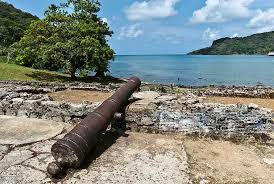Impoverished Colón gets $48 million tourism boost

The restoration of important fortresses of the Spanish colony, the construction of a visitor center, and at least a dozen trails are part of a megaproject of the Government of Panama and the Inter-American Development Bank (IDB) that promote tourism and the economy of the impoverished Caribbean province of Colón, hit by high crime rates.
There are 21 interventions – grouped together in a large ecotourism and cultural project – that are being carried out in Colón with financing of $48 million from the IDB to rescue the historical, touristic, and ecological potential of the area.
At least four works are already finished and the rest are in progress.
The main attractions are the restoration of the fortifications of San Lorenzo and Portobelo, both considered World Heritage since 1980 and included since 2012 in the list of World Heritage in Danger of the United Nations Educational, Scientific, and Culture (Unesco), which in turn give a boost to the economy of that Caribbean province. “This point specifically in San Lorenzo and what is being done in Portobelo will become very important places in the network of tourist sites that Panama has,” the IDB’s leading specialist in Urban Development and Housing, Jesús Navarrete, told EFE from the fort of San Lorenzo, located between the Chagres River and the Caribbean Sea. In San Lorenzo, the San Lorenzo Real de Chagres castle has also been restored, a fortress built at the end of the 16th century by the Spanish to defend against maritime attacks and which is now open to the public despite the fact that the works have not yet been completed.
“The fortification is 40% complete if we see the total set of interventions. Some conservation work is still missing, but this stage has been completed,” the national deputy director of Cultural Heritage of the Ministry of Culture, the architect Itzela Quirós, told EFE.A large visitor center is also being built, which is 60% complete and is scheduled to open in early 2024. In addition, at least a dozen trails are enabled.”(We have done) the rehabilitation of ten trails, which have already been executed and are 100% maintained at a cost of $346,000,” explained Marcela Zúñiga, from the Ministry of the Environment of Panama.
In Portobelo, the Royal Customs building has been recovered and the recently inaugurated Museum of Afro-Panamanian Memory has been created. In addition, various fortifications are also being restored
Environmental Friendly
Navarrete explained that these cultural and environmentally friendly projects “will allow the tourism sector to really be one of the (most) thriving in the economy” of the Central American country and of Colón.“We have several levels of beneficiaries in this. First, the communities within these places will benefit, specifically the community of Portobelo, which has had a lag in services,” he added.
According to the IDB specialist, “there will be economic opportunities” for the communities surrounding the tourist spots, and “the economic development of Colón will be promoted and it will contribute to all the economic development that is being attempted through tourism.” in the country.
Colón is home to the Free Zone, the largest in America, and the Caribbean entrance to the Panama Canal. At the same time, it has the third highest homicide rate in the country and is mired in poverty, with collapsed infrastructure and state neglect.





